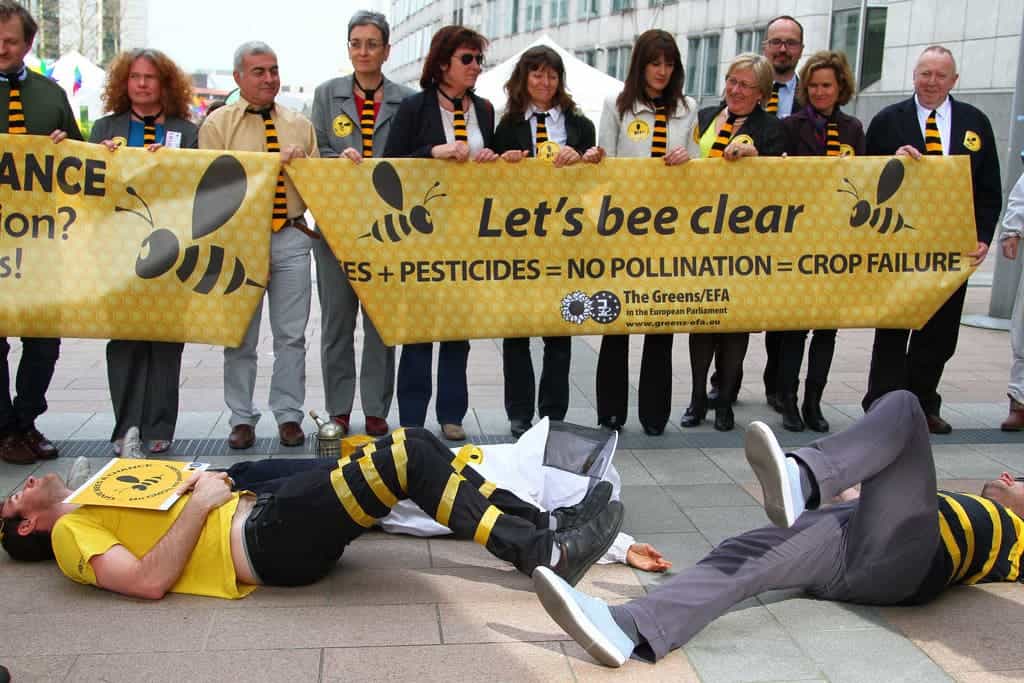Neonicotinoids are a hot topic—the pesticides have been shown to be toxic to bees, which are essential for pollinating the crops in the first place. To harm bees while protecting crops from pests is counterproductive, of course. There is a strong commercial interest in protecting bees as well—to have a good public image and a product that farmers will buy. Researchers from Bayer AG, a company which produces neonicotinoid insecticides, the University of Exeter, and Rothamsted Research have discovered how bees are able to defend themselves against some neonicotinoids. The study was published in the journal Current Biology.

The differences in sensitivity that bees show toward pesticides stem from how these chemicals are broken down by the metabolic enzymes that the bees use in defense against toxins.
“Honeybees are more than 1,000 times less sensitive to the neonicotinoid thiacloprid than imidacloprid, with the latter classified as ‘highly toxic’ but the former categorized as only ‘slightly toxic’ or ‘practically non-toxic’ according to the official categories of the US Environmental Protection Agency,” says Chris Bass from the University of Exeter, United Kingdom. “By utilizing genomic information and state-of-the-art molecular and biochemical techniques, we show that in both honeybees and bumble bees, this selectivity is determined by closely related enzymes, which rapidly break down thiacloprid before it impacts the bee nervous system. Those same enzymes have little to no capacity to break down imidacloprid–thus explaining the differences in bee sensitivity to these compounds.”
The enzymes that the bees use for defense are called cytochrome P450s. The researchers treated bees with a chemical used to block the function of P450 enzymes, causing the bees become much more sensitive to thiacloprid, but they were about the same to imidacloprid.

The researchers then created genetically modified fruit flies, which expressed the different bees’ P450 enzymes. By testing these fruit flies, the researchers found one key P450 enzyme called CYP9Q3 that makes honey bees tolerant to thiacloprid. Bumblebees have a closely related P450 enzyme called CYP9Q4, which performs the same function.
“We identified the same enzyme subfamily degrading thiacloprid in two different bee pollinator species, which raises hope that the mechanism is evolutionarily conserved among other bee pollinators,” Lin Field of Rothamsted Research says. “We also found that these key enzymes are expressed at particularly high levels in Malpighian tubules–the insect equivalent of kidneys–and/or the brain where neonicotinoid insecticides act.”
Already, these findings make it easier to identify strategies that can protect the bees. Screening tests could be used to identify chemicals that can be broken down by bees. Additionally, some other preventative measures can be taken. For example, some fungicides inhibit P450 enzymes so they should not be used alongside neonicotinoids.
It has been difficult to design pesticides that don’t kill bees, because the same protein functions are well conserved across all arthropods. It is for this reason that pesticides can have the unintended consequence of killing arthropods in the soil, air, and water, regardless of whether they are pests or not. It is a positive sign that there is a pathway in bees that can protect them against certain pesticides.
Current Biology, Manjon, Troczka, and Zaworra et al.: “Unravelling the Molecular Determinants of Bee Sensitivity to Neonicotinoid Insecticides” http://www.cell.com/current-biology/fulltext/S0960-9822(18)30230-6






